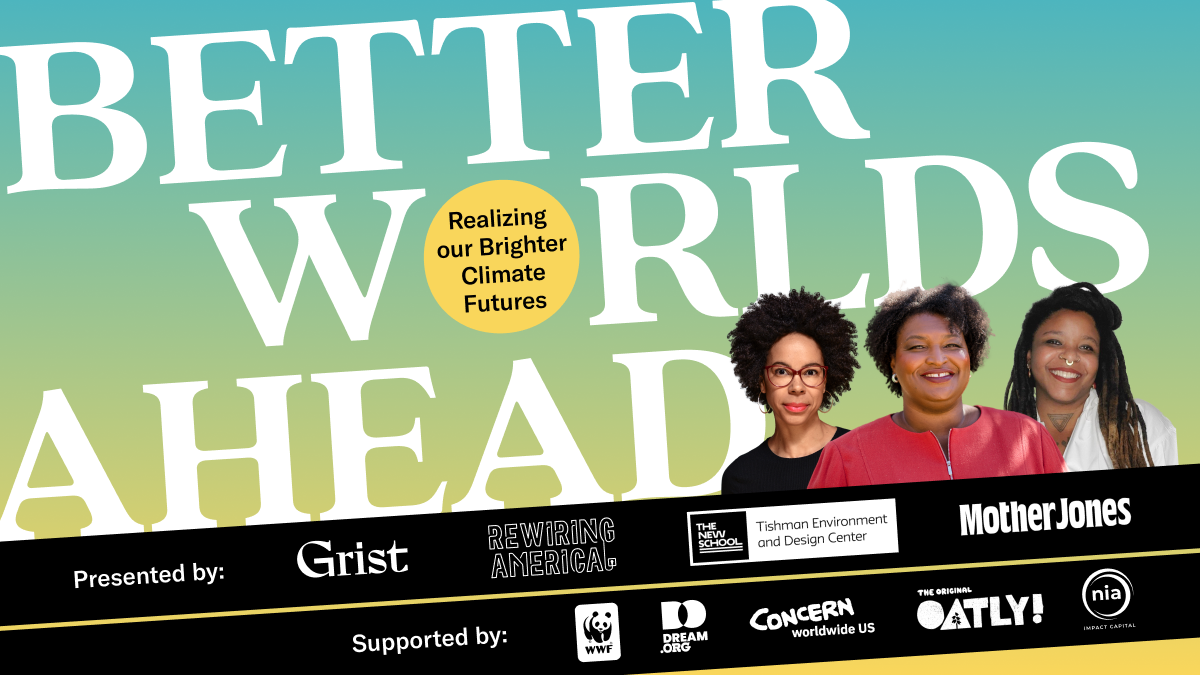
Tishman Environment and Design Center’s “Better Worlds Ahead” Event Imagines a Brighter and More Just Climate Future
The devastation caused by Hurricanes Helene and Milton are part of the “new normal” of climate change, creating emotional, financial, and community upheaval in their wake. But must that be the climate future? A recent event, “Better Worlds Ahead: Realizing Our Brighter Climate Futures,” brought Stacey Abrams and Ayana Elizabeth Johnson to campus for an in-depth conversation about imagining better climate futures, finding motivation for continued action, and looking at places where climate solutions are already taking root.
Although Abrams is known as a politician and not a climate activist, she was able to shed light on the way politics, democracy, and voting intertwine to shape the mitigation and management of climate change. “Democracy is about how we leverage our collective responsibility and our collective vision to make something better. My vision is that we move this out of voting, simply because climate action is something we need and we vote because it is something we want and because we know it’s a transformative space that gets us all of these other things. If we are climate voters, we get high-speed rail. If we are climate voters, we get clean air and clear water. If we are climate voters, our children grow up with lower risks of asthma. And we connect the dots between democracy being fully realized and our right to have political leaders who believe in the whole of us.”
According to Johnson, a co-founder of the Urban Ocean Lab who recently published What If We Get It Right? Visions of Climate Futures, what needs to be done is known; there just needs to be a push to get the work started. “The thing I was trying to get across is that we basically have the climate solutions we need. There’s not a big mystery about what we need to do. We know we need to go to clean energy as fast as possible, and we have the technology to do that. We know we need to shift our transportation—invest in public transit and high-speed rail. We know how to green our buildings, we know how to improve our food systems, we know how to protect and restore our ecosystems and take advantage of the magic that is photosynthesis. It’s not like we have to wait for Silicon Valley to come up with some cute new app and then we can all get to work. We can just start now.”
Discussing her book, she explained that she wants to shift attention from the worst possible outcomes of climate change to visionary ways to shape the future. “What I was trying to get across was that we have all these visions of the apocalypse in pop culture. We have the “what if we get it wrong.” But there’s very little about “what if we get it right.” What are we working towards? What should I run towards? Show me it’s not just a scary void but that this is worth the effort. We get to decide. We’re creating the future.”
As MC, Aisha Shillingford, a multidisciplinary artist and the artistic director of the Black-led creative studio Intelligent Mischief, took the audience through an interactive visioning exercise designed to elicit visions of positive futures. “As people who are standing in the breach, as it were, between the world as we know it and the world as it could be, it is an honor and privilege to be able to dedicate some of our attention to the future and to orient towards that future with hope. Our future generations demand it of us.”
The event, part of Climate Week NYC, was a collaboration between the Tishman Environment and Design Center, Grist, Mother Jones, and Rewiring America. During the event, Tishman Center director Ana Baptista discussed how “the environmental justice movement has seeded for decades and nurtured deepening our democracy. This marks a pivotal movement right now. We have to muster all our determination, all our tenacity to build that better world. Let’s put environmental and climate justice on the ballot this November. We want to vote for environmental justice nationally and locally. We have an online campaign, Environmental Justice Is Democracy. You can join us on our hashtag #EJISDemocracy and add your voice to why environmental justice is an integral part of our democracy.”
In his closing remarks, New School president and co-founder of the Tishman Center Joel Towers reminisced, “Two decades ago, when we started Tishman, to think that an event like this would be possible was almost unimaginable. It’s been such a joy to be here today. I want to call out Michelle DePass, who was the director of Tishman after me and before Ana. The center would not have been grounded in environmental justice in the ways that it is without Michelle DePass.”
Referencing Johnson’s description of her activism as “tenacious” and Abrams’ description of her work as “determined,” Towers said, “What a dream to have Stacey and Ayana on the stage and Aisha starting us off. This was an incredible opportunity for all of us to see and to dream, and to be tenaciously determined. That’s how I’m leaving this room, tenaciously determined to live up to the promise they have put in front of us.”